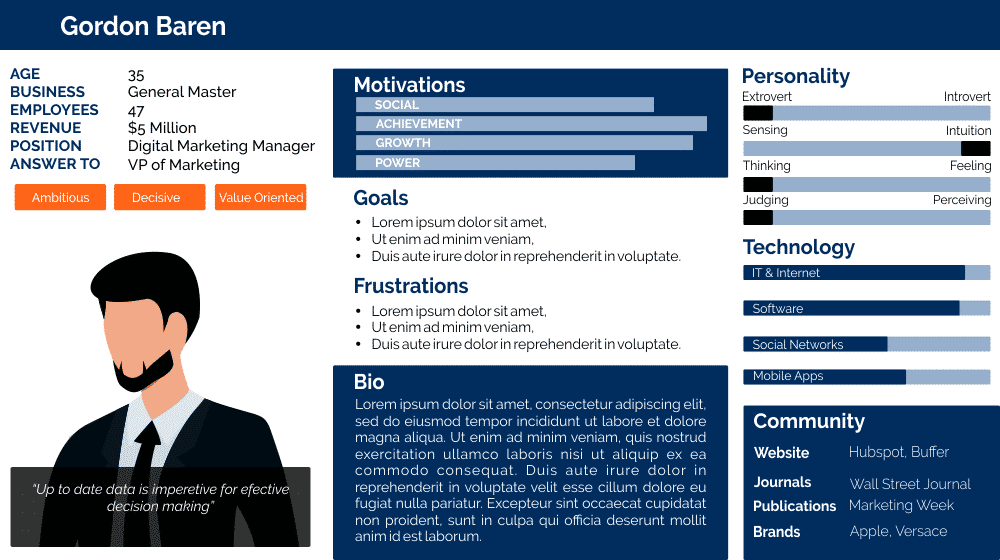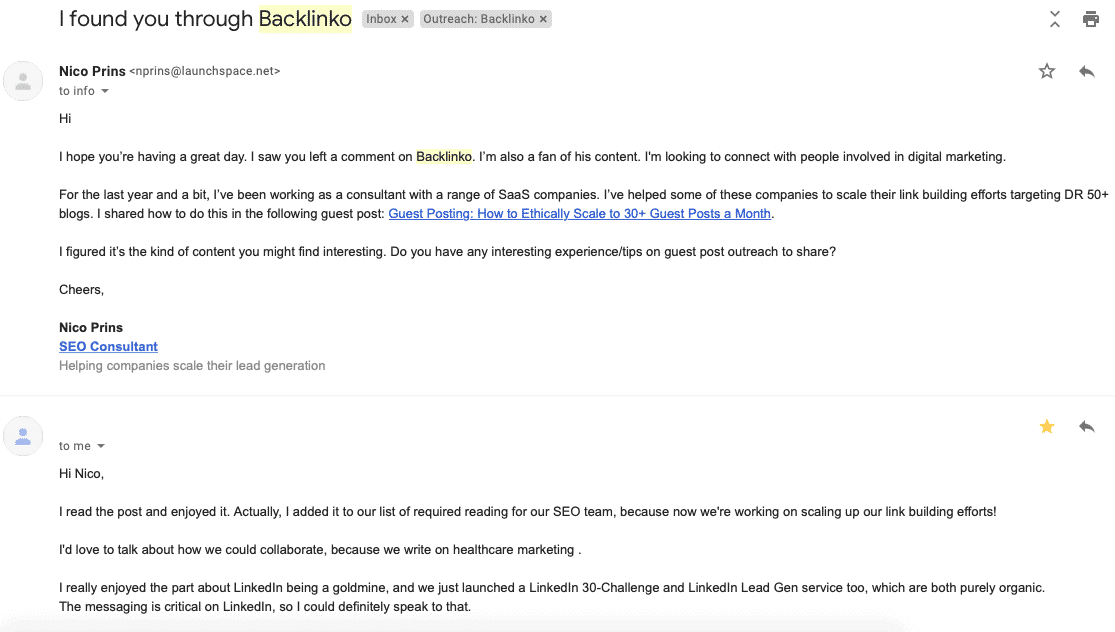8 Steps to Create an Effective Strategy

When a football club wins a game, you often hear the manager say that the “team stuck to the game plan.” The link between success and planning is well understood. It’s why the army does “war games” and B2B content marketing teams create a content marketing strategy.
In this guide, I’ll share an eight-step framework you can use to create an effective B2B content marketing strategy for your business. It’s a strategy that will help generate fresh leads for your business. Let’s jump right in.
Step 1: Get to Know Your Customers
An effective B2B content marketing strategy starts with an understanding of your target audience. There are two popular methods that businesses use to depict their customers.
The first is a buyer or customer persona.
A buyer persona is a composite of your ideal customer. It’s not a real person, rather a caricature of your ideal customer. When creating your buyer persona, you’ll do things like defining their job title, the type of company they work for, and the challenges that they face.
Below is an example of a buyer persona.

Source: StartupBros
If you don’t want to create an imaginary customer, you could always refer to your real customers.
You’d include the same type of information about your real customer or customers as you would your customer persona. In both instances, the way you gather the data about your customers would be similar. You’d:
- Review all of your customers and try to identify shared characteristics
- Pick one or more customers that best fit your target audience
- Analyze all of the available information you have about them
- Conduct interviews with your customers to understand why they use your services
Creating a buyer persona, or just using information about a real customer will help you understand who purchases the goods or services that you offer. A good understanding of your target audience will provide a lot of value to your company. You can provide this information to your sales team, copywriters can use it when creating sales pages, and, of course, you can refer to this information when creating your B2B content marketing strategy.
In the context of your content marketing strategy, an understanding of your customers’ motivations and problems will help you identify topics to cover, and which marketing channels to utilize.
Step 2: Map the Customer Journey
You now have an understanding of your customer. If you’re working for an established business, you will want to review the customer journey. Tracking the customer journey is a complex process. There are probably multiple touchpoints that your customer went through before they made a purchase.
Most customers will engage with your company across different channels during the customer journey. For example, they might first find you through your website blog, then they see a Tweet on social media. Two months later they want to purchase the product you offer and remember your company. They visit your site and engage with your chatbot. Then they research the product on a review site, before finally making a purchase.
That might sound like a complicated customer journey, but it’s probably a lot simpler than the one your customers go through. Tracking this journey across multiple channels is a headache. Most companies don’t bother trying. A few use expensive tools to track the customer across a couple of channels. A minority can track the majority of the customer journey.
With the information you have available, try to piece together your customers’ journey. This might be easiest to achieve through interviews, but if you can access data then I recommend you utilize it.
Step 3: Conduct Competitor Analysis
The final piece of research for your B2B content marketing strategy involves spying on your competition. Or, to give it a more business-friendly name, undertaking competitor intelligence.
Competitor intelligence will help you understand where your competition is achieving success. If you can understand what they are doing right, or even identify what they are doing wrong, you will learn something that you can use for your business planning.
Before you start your competitor intelligence, list some of your ideal outcomes from this research. For example, you might want to discover:
- Through what channels do they share their content?
- Which channel has the highest level of engagement?
- How often do they publish content?
- How much traffic do they get to their site & what are their most important pages?
- I’m sure you get the idea.
What you’re looking to gain are insights that can help you acquire customers quickly, or sidestep expensive mistakes that cost your company valuable resources. After all, if your competitor made an expensive mistake that cost them thousands of dollars, it would be pretty silly of you to repeat the same thing.
Step 4: Create Your B2B Content Marketing Strategy
Once you have completed your research, it’s time to put together your B2B marketing plan.
The content marketing strategy should be based on the insights you gained through your research.
Most content marketing strategies will incorporate an element of digital marketing. However, you might have a paid advertising budget for newspapers and magazines or television. Regardless of what channels you use, the end goal is the same; to create a B2B content marketing strategy that you can share, and everyone understands.
At the end of the planning stage, you should have an answer to the following questions:
- Which marketing channels will you use?
- What type of content will you produce?
- How frequently will you publish content on each channel?
- How will you promote the content?
- How will you convert the leads into customers?
- Who is responsible for doing the work?
You should be able to justify your answers based on the insights you gained through your research.
These are just top-level questions you need to answer. There’s a lot of additional work you’d need to do before you could implement your B2B content marketing strategy. For example, if you focused on blog content, you’d need to define what keywords you will target, decide who will write the content, and a bunch more besides.
Create a comprehensive plan for a quarter first. For the rest of the year, you want a plan with broad brushstrokes.
It will take time to create a comprehensive B2B content marketing plan. It’s worth putting time into developing your strategy now, as there’s significant pay off later.
Step 5: Define Your Key Performance Indicators
With your content marketing plan in place, it’s time to consider how you’ll track your campaign’s success. Most companies use Key Performance Indicators, which are often referred to by the abbreviation KPIs, to track success.
You should put a system in place to measure the success of your campaign. It’s common sense.
Ideally, the primary KPI for your content marketing plan will be a financial target. For example, you might say you want to generate $100,000 this quarter from content marketing. Assuming you have put a system in place that tracks attribution, you can then split that $100,000 across the various marketing channels you will use. For example:
- $40,000 from advertising in magazines
- $60,000 from the blog
You then try and explain how a department member of staff will help you hit that goal. Let’s take the revenue figure for the blog as an example. Below are some hypothetical performance metrics you might use:
- Publish one new article a week on the blog
- Publish 20 guest posts on authority blogs a month
- Increase website visitor numbers by 3k a month
- Grow the email list by 500 new subscribers a month
These goals should filter into your primary B2B content marketing goal. The ability to logically break your KPIs down in this way will help you put an appropriate plan in place.

Source: Launch Space
Revenue is an important goal, but it’s not the only one. Below are some additional factors that could be important to your business:
- Establishing audience trust
- Showcasing the benefits of your product or service
- Overcoming sales objections
- Retaining customers and making them ambassadors for your brand
Your resources are precious and limited, so you need to prioritize. Which goals will you focus on? Once you’ve decided on your priorities, utilize the data you have available to track relevant metrics and determine if your content marketing strategy is succeeding.
What works for other brands won’t necessarily work for your business and industry. Continually return to your business goals and focus on only the relevant metrics.
Step 6: Create & Promote Your Content
You now have a strategy and hopefully a timeline in place for content creation. Effective team collaboration will play a big part in your ability to create the content to set deadlines.
How you promote your products or services will vary according to your business. Most B2B businesses and decision-makers at companies maintain a presence on LinkedIn. According to the Content Marketing Institute, 66% of content marketers rate LinkedIn as the most effective B2B social platform, followed by Twitter (55%) and YouTube (51%).

LinkedIn is aimed at decision-makers, such as senior executives, making it one of the best ways to reach these influential people. You can also join groups relevant to your niche to connect with others in your industry.
While LinkedIn is king right now, don’t neglect other channels. You should also be promoting your content on your Facebook and Twitter pages, email marketing communications, and YouTube channel if you have one.
Social media is not the only method of spreading the word about your content. For example, I utilize direct outreach to put the content I produce in front of key decision-makers at the companies I want to work with. Here’s a three-step process:
- Create a list of relevant decision-makers at the companies you want to work with
- Find the contact details of these decision-makers
- Send a short informative introduction email showcasing your work
It’s a straightforward strategy, however, it might seem abstract or ineffective. The screenshot below reveals how I incorporated direct outreach utilizing content into my B2B content marketing strategy.

You can run this type of campaign without any paid tools. If you have a budget, it’s worth investing in some premium tools. For example, I use Right Inbox for scheduling recurring emails. You can see how this feature works here.
It’s a big timesaver when running outreach campaigns. You can set up a series of automated emails that get sent out over time. Sending multiple emails to a person over a set time period maximizes the response rate.
Step 7: Let Your Audience Engage With You
Content marketing is a two-way street. While you provide your audience with valuable content, they will engage with you by liking, sharing, and commenting on your content.
If you’re entering a new market or are just starting to do content marketing, most people won’t trust your brand right away. Who does your audience trust? People like them – their peers, colleagues, friends, and even the influencers they follow on social media. The content shared by those they know and trust is more likely to pique their interest. This is something you can tap into. And, yes, B2B influencer marketing is alive and well.
While user-generated content is more commonly associated with business-to-customer (B2C) marketing, you can also use it for your B2B brand. Here’s an example from tech giant IBM:

On its LinkedIn page, IBM features projects and content from its users – in this case, the UN Sustainable Development Solutions Network. The story is related to the COVID-19 pandemic, a current issue that is on everyone’s minds.

Aside from featuring product use cases, you can also engage your users through contests and giveaways. Cisco, runs the Innovation Challenge, which always attracts a diverse set of entries from around the world.
Step 8: Track Trends & Review Results
The digital marketing world moves quickly. Therefore, it is vital to keep your finger on the pulse of relevant trends to ensure your content is current and up to date. Tracking trends can help you adapt your strategy, ensuring it is still relevant down the line.
In addition to tracking content marketing trends, you should be continually reviewing your results. Your content marketing strategy should evolve as the market and landscape change. The ability to adapt quickly is the secret to ensuring that your brand stays relevant, competitive, and at the top of its game.
Wrapping Up: Why strategy is crucial to content marketing
Content marketing is highly competitive. Without a clear and coherent content marketing strategy, you’ll end up wasting time and resources. You might even end up losing members of your audience – the opposite of what you want!
Your strategy needs to be grounded in data and research, be responsive to what your audience wants, and move prospects through the stages of the customer journey. You also need to keep abreast of current and future content marketing trends and ensure you’re using the right channels to reach key decision-makers.
Content marketing takes practice to get right. Every piece of content you publish is a learning opportunity, and every market study is a chance to improve your strategy.
Here’s to crafting a B2B content marketing strategy that works for your brand!


